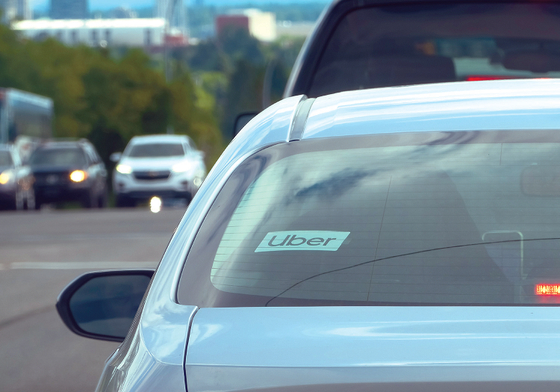Comparison of Waymo and Uber ride results in LA
Waymo costs $37.64 on average per ride, more expensive even without tipping
Call waiting time doubles, driving time takes 121% longer
Strict compliance with laws… There is also an opinion that “it is safe without a driver”
Waymo robotaxi driving near Wilshire Road in LA. Reporter Park Nak-hee

Uber is one of the car sharing service companies.
Waymo, a self-driving robotaxi that recently expanded its services in LA, was soundly defeated in a head-to-head competition with a human-driven car sharing service.
Forbes, an economic magazine, recently compared 50 rides among Waymo, Uber, and Lyft services in the LA area and found that Waymo was relatively inefficient compared to Uber and Lyft in terms of time and cost.
Looking at usage fees, Waymo averaged $37.64 per ride, which was $9.50 more expensive than the average ($28.14) of Uber ($28.30) and Lyft ($27.99). Waymo does not include tips, but even if you pay an additional 20% tip to Uber or Lyft drivers, Waymo is still $3.87 more expensive.
The difference was even more noticeable in the service use time. The waiting time from app call to pick-up was an average of 3.4 minutes for Uber (3.3 minutes) and Lyft (3.6 minutes), but Waymo took more than double the average of 7.2 minutes.
The travel time to the destination after boarding took an average of 15 minutes and 20 seconds for Uber (16 minutes and 59 seconds) and Lyft (14 minutes and 41 seconds), but Waymo took an average of 33 minutes and 58 minutes, which is 121% longer.
For example, while the car sharing service from Santa Monica to downtown LA took 29 minutes, Waymo took 1 hour and 18 minutes. This difference in driving time was interpreted as the fact that Waymo drives in strict compliance with the speed limit on the road.
In addition, Waymo was unable to completely take people to their destination in some sections and sometimes had to be walked, revealing its current technological limitations.
In addition, Waymo can operate autonomously at regulated speeds in limited areas mapped by engineers and cannot drive on highways, so it may be preferred by consumers who value safety, but may not be suitable for those who want to move quickly.
On the other hand, some Koreans who actually rode the plane said they preferred Waymo. Mr. K, an office worker who used Waymo during his lunch hour in LA Koreatown, said, “I was worried before boarding the car, but when I actually rode it, I was able to feel that I was driving safely. “The cost is also reasonable considering there are four people on board.”
Mr. H, a housewife, said, “I often take my children for rides in Uber, but I am concerned after seeing an article recently reporting that an Uber driver sexually assaulted a high school student. “I think Waymo, which doesn’t have a driver, would be safer,” he said.
Waymo is an industry leader, providing 150,000 rides and 1 million miles of driverless driving each week. Despite these achievements, according to JD Power’s Mobility Trust Index survey last year, only 37% felt comfortable riding in unmanned self-driving cars, so it is unclear whether Waymo can replace existing car sharing services that are already in place.
According to a 2019 Pew Research survey, 71% of adults living in cities with annual incomes of $75,000 or more had experience using ride-sharing services.
Therefore, Waymo needs to instill confidence in self-driving cars among an additional 35% of consumers in order to compete with car sharing services to attract customers.
Through this survey, Forbes assessed that Waymo may be attractive to consumers who want a new experience, but it is currently difficult to find a reason to ride beyond simply being driven by a robot, so more challenges remain to secure popular demand.
Reporter Park Nak-hee [email protected]

1. How do you think the recent comparison of Waymo and Uber ride results in LA will impact their respective ride-hailing services?
2. What are the key factors that contribute to the higher cost of Waymo rides compared to human-driven Uber and Lyft services?
3. Do you think the significant increase in driving time for Waymo rides is due to their adherence to traffic laws and safer driving practices, or are there other factors at play?
4. What are some of the challenges that consumers face when using autonomous vehicles like Waymo for the first time, and how can these be addressed?
5. How important is trust and safety in the usage of ride-sharing services, particularly with the recent news of Uber drivers engaging in misconduct?
6. Can you provide any insights into the demographics of LA residents who use ride-sharing services, and how this might affect the adoption of autonomous vehicles like Waymo?
7. Do you think the current technological limitations of Waymo (e.g. inability to drive on highways) will hinder its widespread adoption, or is it seen as a necessary precaution for safety reasons?
8. How can companies like Waymo and Uber maintain affordability while also ensuring the safety and reliability of their services?
9. Are there any potential benefits or drawbacks to using Waymo’s robotaxi service for regular commuters versus using traditional public transportation options?
10. What do you think is the future of ride-hailing services in urban areas like LA as more companies like Waymo enter the market with self-driving cars?

![[36] Hanroro EP 1st album ‘Abnormal Flight’ [36] Hanroro EP 1st album ‘Abnormal Flight’](http://img1.daumcdn.net/thumb/R1280x0/?fname=http://t1.daumcdn.net/brunch/service/user/ampm/image/_sGtSi6Kqv3cSV8UhwAfYOKg80g.jpg)